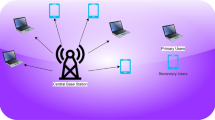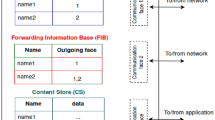Abstract
In wireless access, transmitter nodes need to make individual decisions for distributed operation and do not necessarily cooperate with each other. We consider a single-receiver random access system of non-cooperative transmitters with the individual objectives of optimizing their throughput rewards, transmission energy costs and delay costs. The non-cooperative transmitter behavior may be purely selfish or may also reflect malicious objectives of generating interference to prevent the successful transmissions of the other nodes as a form of denial of service attack. Our goal is to evaluate the interactions between selfish and malicious nodes that have the dual objectives of optimizing their individual performance measures and blocking the packet transmissions of the other selfish nodes. We assume saturated packet queues of infinite buffer capacities and consider a general multi-packet reception channel that allows packet captures in the presence of simultaneous transmissions. In this context, we formulate a non-cooperative random access game of selecting the individual probabilities of transmitting packets to a common receiver. We derive the non-cooperative transmission strategies in Nash equilibrium. The analysis provides insights for the optimal strategies to block random access of selfish nodes as well as the optimal defense mechanisms against the possible denial of service attacks of malicious nodes in wireless networks. The results are also compared with the cooperative equilibrium strategies that optimize the total system utility (separately under random access and scheduled access). A pricing scheme is presented to improve the non-cooperative operation. For distributed implementation, we formulate a repeated game of the best-response strategy updates and introduce adaptive heuristics (based on the channel feedback only) provided that the system parameters are not explicitly known at the individual transmitters.















Similar content being viewed by others
Notes
The views and conclusions contained in this document are those of the authors and should not be interpreted as representing the official policies, either expressed or implied, of the Army Research Laboratory or the US Government.
References
Rao, R., & Ephremides, A. (1988). On the stability of interacting queues in a multiple-access system. IEEE Transactions on Information Theory, 34(5), 918–930.
Szpankowski, W. (1984). A multiqueue problem: Bounds and approximations. In Performance of Computer Communication Systems, Proc. IFIP Congr.
Anantharam, V. (1991). Stability region of the finite-user slotted ALOHA protocol. IEEE Transactions on Information Theory, 37(3), 535–540.
Luo, W., & Ephremides, A. (1999). Stability of N interacting queues in random-access system. IEEE Transactions on Information Theory, 45(5), 1579–1587.
Naware, V., Mergen, G., & Tong, L. (2005). Stability and delay of finite-user slotted ALOHA with multipacket reception. IEEE Transactions on Information Theory, 51(7), 2636–2656.
Luo, J., & Ephremides, A. (2006). On the throughput, capacity, and stability regions of random multiple access. IEEE Transactions on Information Theory, 52(6), 2593–2607.
MacKenzie, A. B., & Wicker, S. B. (2001). Game theory and the design of self-configuring, adaptive wireless networks. IEEE Communications Magazine, 39, 126–131.
MacKenzie, A. B., & Wicker, S. B. (2001). Selfish users in Aloha: A game theoretic approach. In Proc. Fall 2001 IEEE Vehicular Technology Conference. Atlantic City.
Altman, E., El-Azouzi, R., & Jimenez, T. (2004). Slotted Aloha as a stochastic game with partial information. Computer Networks, 45, 701–713.
Marbach, P., & Pang, R. (2005). Transmission costs, selfish nodes, and protocol design. In Proc. WiOpt’05: Modeling and Optimization in Mobile, Ad Hoc and Wireless Networks. Riva del Granda.
Sagduyu, Y. E., & Ephremides, A. (2003). Power control and rate adaptation as stochastic games for random access. In Proc. 42nd IEEE Conference on Decision and Control (pp. 4202–4207). Maui.
MacKenzie, A. B., & Wicker, S. B. (2003). Stability of multipacket slotted Aloha with selfish users and perfect information. In Proc. INFOCOM 2003 (pp. 1583–1590). San Francisco.
Sagduyu, Y. E., & Ephremides, A. (2006). A game-theoretic look at throughput and stability in random access. In Proc. IEEE Military Communications Conference MILCOM 2006. Washington, DC.
Jin, Y., & Kesidis, G. (2002). Equilibria of a non-cooperative game for heterogeneous users of an Aloha network. IEEE Communications Letters, 6(7), 282–284.
Lee, J.-W., Chiang, M., & Calderbank, A. R. (2006). Utility-optimal medium access control: Reverse and forward engineering. In Proc. IEEE INFOCOM 2006. Barcelona.
Inaltekin, H., & Wicker, S. (2005). A one-shot random access game for wireless networks. In Proc. 2005 International Conference on Wireless Networks, Communications and Mobile Computing (pp. 940–945). Maui.
Wang, D., Comaniciu, C., & Tureli, U. (2006). Cooperation and fairness for slotted Aloha. Springer Wireless Personal Communications, Special Issue on Cooperation in Wireless Networks.
Zander, J. (1991). Jamming in slotted ALOHA multihop packet radio networks. IEEE Transactions on Communications, 39(10), 1525–1531.
Liu, Y., Comaniciu, C., & Man, H. (2006). A bayesian game approach for intrusion detection in wireless ad hoc networks. In Proc. GameNets (Workshop on Game Theory for Networks). Pisa.
Gupta, V., Krishnamurthy, S. V., & Faloutsos, M. (2002). Denial of service attacks at the MAC layer in wireless ad hoc networks. In Proc. IEEE Military Communications Conference MILCOM 2002. Anaheim.
Radosavac, S., Cardenas, A. A., Baras, J. S., & Moustakides, G. V. (2007). Detecting IEEE 802.11 MAC layer misbehavior in ad hoc networks: Robust strategies against individual and colluding attackers. Journal of Computer Security, 15(1), 103–128.
Shamma, J. S., & Arslan, G. (2005). Dynamic fictitious play, dynamic gradient play, and distributed convergence to Nash equilibria. IEEE Transactions on Automatic Control, 50(3), 312–327.
Sagduyu, Y. E., & Ephremides, A. (2006). A game-theoretic look at simple relay channel. Journal of Wireless Networks, 12(5), 545–560.
Sagduyu, Y. E., & Ephremides, A. (2007). On joint MAC and network coding in wireless ad hoc networks. IEEE Transactions on Information Theory, 53(10), 3697–3713.
Acknowledgements
This work is supported in part by the Office of Naval Research under grant 528773 and by the Department of Defense under MURI grant 433859. Prepared through collaborative participation in the Communications and Networks Consortium sponsored by the US Army Research Laboratory under the Collaborative Technology Alliance Program, Cooperative Agreement DAAD19-01-2-0011. The US Government is authorized to reproduce and distribute reprints for Government purposes notwithstanding any copyright notation thereon. The material in this paper was presented in part at WiOpt’07, 5th Intl. Symposium on Modeling and Optimization in Mobile, Ad Hoc, and Wireless Networks, Apr. 2007, Limassol, Cyprus.
Author information
Authors and Affiliations
Corresponding author
Rights and permissions
About this article
Cite this article
Sagduyu, Y.E., Ephremides, A. A game-theoretic analysis of denial of service attacks in wireless random access. Wireless Netw 15, 651–666 (2009). https://doi.org/10.1007/s11276-007-0088-8
Published:
Issue Date:
DOI: https://doi.org/10.1007/s11276-007-0088-8




